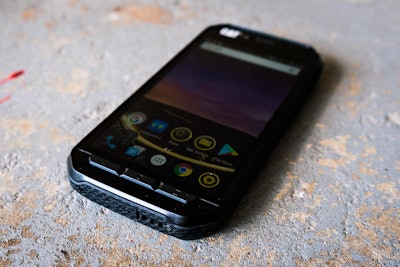
In the nearly five years since Caterpillar entered the smartphone market with its first Android rugged phone, the B15, the company’s phones have entered a state of refinement. No device to date better illustrates that than the new Cat S41.
Cat announced this phone back in September and sent the device along to me for review a few weeks back. It manages to be at once the company’s most unexciting and all-around best phone to date. Here’s why.

Design

Since 2014 Cat has worked with UK design firm Bullitt Group to design each of its smartphones. Not only has Bullitt has done a nice job of capitalizing on and working in the iconic Cat logo into these designs, but they’ve also succeeded in designing devices that earn the right to wear that logo and all the assumptions of quality and ruggedness that come along with it.
In the past, each of Cat’s major phone releases have featured an aluminum band around the display. The exposed metal not only added a nice, premium look to the phones, but it served as a tip of the hat to steel, equipment and construction. The amount of aluminum was reduced a bit on the S40, but on the new S41 it has been foregone altogether in favor of an all-black plastic casing. This doesn’t make the phone any less rugged—the S41 still carries IP68 and Military Standard 810G ratings—but it does detract a bit from the phone’s look and feel.
The plastic casing is imprinted with a honeycomb-like pattern that gives the S41 substantial grip. Adding to the feel of this phone is a fair amount of heft without feeling too thick or heavy.
Just below the S41’s 5-inch, 1080p display are three navigation buttons: Back, Home and Multitasking. Just about every phone manufacturer has eliminated buttons from the front of their devices and while I’d like to see Cat Phones go in the same direction, I’m pretty sure Cat and Bullitt’s decision to stick with the physical buttons has something to do with making navigating the phone with gloves on a bit easier.

As far as the rest of the buttons on the S41 go, a golden programmable key that can be assigned to open certain apps with a single press sits on the left side of the device, while the power button and volume rocker are on the right side. To be frank, having the power and volume buttons on the same side is a design decision that drives me up the wall. I’d estimate that 70 percent of the time I was trying to wake the phone or lock it, I’d hit a volume button instead of the power button. Compounding this problem is the fact that the only way to wake the screen on the device is by pressing the power button. There’s no raise to wake feature like you see on other Android phones, and pressing the home button on the front of the phone can’t wake it either.
Though most phone makers are starting to drop support of the headphone jack, the S41 still sports one. The phone charges via a Micro USB port at the bottom while the SD and SIM card slots are near the top left corner of the phone. All ports are sealed by water-tight flaps in the casing.
We’ll end this section on the screen. It’s the nicest I’ve seen on a Cat Phone to date. Even Cat’s more expensive and FLIR camera-toting S60 sports a lower-resolution 720p display. The S41 display offers plenty of brightness in direct sunlight and color reproduction was solid with acceptable contrast on the blacks and no over-saturation on other colors. Keep in mind that the display on the S41 can be used with wet hands and with gloves on. My one quibble with the screen: It’s a fingerprint magnet.
Performance

Every Cat Phone to date has struggled when it comes to performance. I was hoping the S41 would fare better since it was outfitted with respectable specs like an eight-core CPU and 3 gigabytes of RAM, but the phone still doesn’t even get close to matching the performance of the latest and greatest from Android phone makers like Samsung and LG. It’s disappointing but not surprising since this phone costs about half of what the top phones on the market cost.
I tested the S41’s performance with the GeekBench app which scored single-core processing (lightweight tasks like web browsing and email) at 783. That places the S41’s single-core processing power well below phones like Samsung’s Galaxy Note 4 which came out three years ago and scores a 955.
Because of all the processor cores the S41’s CPU has, its multi-core score is a bit more respectable. On this test GeekBench scored the S41 at 2697, not too far below the 2015 Huawei Nexus 6P’s score of 2848, but still not quite as good as the Note 4’s 3043.
But I didn’t just form my opinion on the phone’s performance based on these scores. As far as real-world usage goes, the S41 is a pretty mixed bag.
The phone is fairly snappy in normal operation due in large part to Bullitt’s decision to go with a nearly stock Android installation. Switching apps isn’t exactly buttery smooth but moves along at a good clip and exiting out to the home screen from apps always went without a hitch. For 90 percent of what you’ll do with this phone, you can expect acceptable performance. However, with applications like Facebook and Snapchat, which tend to tax a phone a bit more than other apps, I ran into many slowdowns and crashes. I also found shooting video within Instagram and Snapchat to be extremely laggy, though I’ve seen similar problems on other Android phones as well.
Camera

While the S41’s camera represents an improvement over past Cat Phone cameras, it remains one of the most disappointing pieces to the phone.
Looking at the specs, you’d expect a fair amount of improvement from the S41’s lenses. The rear shooter is 13 megapixels while the front camera is 8MP—specs are on par with just about every high-end Android phone on the market. However, the images the S41 creates are years behind other phones. Most images are washed out and have a hazy quality to them.
While the camera app itself performs at a reasonable clip, focusing is slow and, as I found with many images, oftentimes doesn’t work very well. On many images I assumed were in focus, the subject turned out to be rendered very soft. Plus, even in bright conditions with lots of daylight there’s just an unacceptable amount of noise present in the photos. Obviously, if you’re shooting indoors in lower light, these problems only intensify. Another troubling thing I noticed was that in very bright daylight conditions some lens flare/reflection from the glass protecting the lens would pop up. You can check out some of the images the S41 captured in my testing below.
Battery
In contrast to the cameras, the S41’s battery is one of its most impressive features. Bullitt packed in a huge 5,000 mAh battery into the S41. Just to give you an example of how much power that supplies, Samsung’s top tier Galaxy Note 8 has a 3,300 mAh battery.
Under GeekBench’s battery test, which subjects the phone to a CPU load of around 90 percent while keeping the screen on (brightness was set to 65 percent), the S41 stayed alive for 10 hours before the battery died. Ten hours of uninterrupted usage is flat out impressive. In other words, you should be able to get two straight days of normal use out of the S41 without needing to charge it.
In fact, the S41 has so much battery under the hood that Cat has included a battery sharing feature in the phone that allows you to hook up other devices and charge them. The phone includes a cable with a USB port on one end allowing you to plug in other phones and anything else you might need to charge up. When you plug in the Battery Share cable, the Battery Share app immediately opens up if the phone is on. It gives you the option of a standard charge or a fast charge. If you select Fast, the S41 powers down in order to charge the other device as quickly as possible. The app also allows you to select at what battery percentage you’d like the S41 to cut off the juice.
Conclusion

Though it’s a bit easier on the wallet and doesn’t have a thermal imaging feature like the S60, the S41 is the best Cat Phone to date.
Though the camera and overall performance handicap the S41, for the vast majority of users this phone was designed for, it offers ample speed and good enough picture and video quality.
Like the Cat Phones before it, the S41 meets two of the most important needs to a smartphone customer: it’s not easy to break and the battery can last for days. Since launching the B15 in 2013, Cat and Bullit have found an excellent form factor for a rugged Android device and have iterated and refined the design into a phone that I can highly recommend—especially at a price of just $450.














